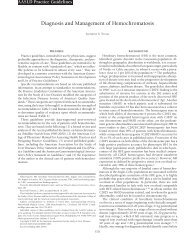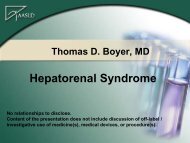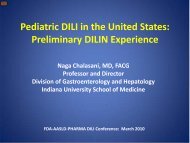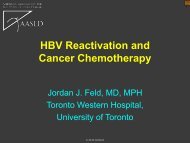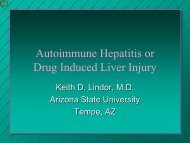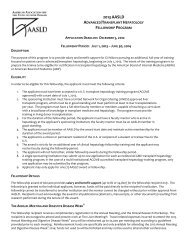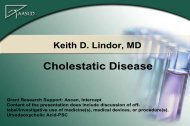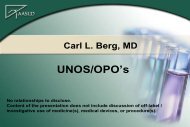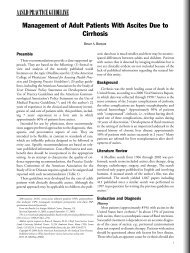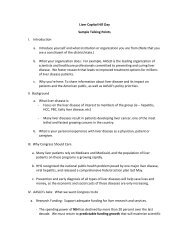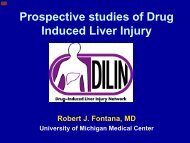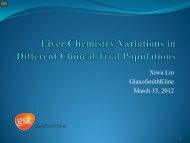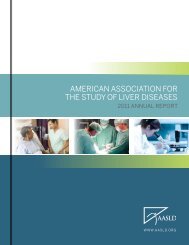causality assessment in drug induced liver injury - AASLD
causality assessment in drug induced liver injury - AASLD
causality assessment in drug induced liver injury - AASLD
You also want an ePaper? Increase the reach of your titles
YUMPU automatically turns print PDFs into web optimized ePapers that Google loves.
Note - presentation notes may be read by double click<strong>in</strong>g on the icon to the leftGlobalProduct PatientSafetyLiver Transplantation forDrug Induced Acute Liver Failure <strong>in</strong> the USAn UpdateArie Regev, M.D.Global Patient SafetyEli Lilly and Company
DILI and Acute Liver Failure (ALF)• DILI is the lead<strong>in</strong>g cause of ALF <strong>in</strong> the US 1 and EU 2• Exceeds all other ALF causes comb<strong>in</strong>ed• Liver transplant is the ultimate treatment for DIALF• The United Network for Organ Shar<strong>in</strong>g (UNOS) databaseconta<strong>in</strong>s data on LT performed <strong>in</strong> the US s<strong>in</strong>ce 19871. Lee WM, et al. Hepatology 2008;47:1401-14152. Larrey D, Pageaux GP. Eur J Gastroenterol Hepatol 2005;17:141-143.3.
Outcome of Liver Transplantation for Drug Induced Acute LiverFailure <strong>in</strong> the United States. Analysis of the United Network forOrgan Shar<strong>in</strong>g Database.Ayse L. M<strong>in</strong>dikoglu, M.D., M.P.H. 1 , Laurence S. Magder, Ph.D., M.P.H. 2and Arie Regev, M.D. 3From the 1 Department of Medic<strong>in</strong>e, Division of Gastroenterology and Hepatology,University of Maryland School of Medic<strong>in</strong>e, Baltimore, MD;2Department of Epidemiology and Preventive Medic<strong>in</strong>e, Division of Biostatistics andBio<strong>in</strong>formatics, University of Maryland School of Medic<strong>in</strong>e, Baltimore, MDand 3 Global Patient Safety, Eli-Lilly & Company, Indianapolis, IN
Company ConfidentialCopyright© 2007 Eli Lilly and Company
Objectives Identify patterns and demographics of DIALF requir<strong>in</strong>g LT‣ Predisposed groups‣ Risk factors‣ Typical presentation Identify <strong>drug</strong> groups associated with DIALF and LT Identify lead<strong>in</strong>g <strong>drug</strong>s associated with DIALF and LT Determ<strong>in</strong>e survival rates after LT for DIALF
Methods Retrospective cohort study UNOS database from Oct 1987 through Dec 2006 Patients with diagnosis other than DIALF were excluded Collected for each patient:‣ 21 recipient variables‣ 6 donor variable Age, gender, ethnicity, life support, dialysis, serum total bilirub<strong>in</strong>,serum creat<strong>in</strong><strong>in</strong>e, serum album<strong>in</strong>, serum ALT, PT-INR, cold ischemiatime, warm ischemia time, multiorgan transplant, days on the <strong>liver</strong> wait<strong>in</strong>glist, transplant region, ABO blood type, hepatitis B surface antigen(HBsAg), hepatitis C virus antibody (HCVAb), number of transplants, etc.
Results A total of 73,977 <strong>liver</strong> transplantations performed <strong>in</strong> the USbetween October 01, 1987 and Dec 31, 2006 (19 years)(Russo et al:51,741) 661 patients diagnosed as DIALF (Russo et al: 357)‣ 567 adults‣ 94 pediatric (
Drug groups among DIALF patientsundergo<strong>in</strong>g <strong>liver</strong> transplant
Drug Group (Total) Drug PatientsTotal 661Acetam<strong>in</strong>ophen 265Anti-TB 50INH alone 48INH & another anti-TB 2Antiepileptic 46Phenyto<strong>in</strong> 20Valproic acid 20Carbamazep<strong>in</strong>e 3Other antiepileptics 3Antibiotics 39Nitrofuranto<strong>in</strong> 12Ketoconazole 8Amoxicill<strong>in</strong> and clavulanate 5Trimethoprim-sulfamethoxazole 5Other antibiotics 9
Drug Group (Peds.) Drug PatientsTotal 94Acetam<strong>in</strong>ophen 27Antiepileptic 22Valproic acid 16Phenyto<strong>in</strong> 3Other antiepileptics 3Anti-TB INH 8Propylthiouracil 6
ALF Due to Non-APAP Drugs Total number of ALF cases due to non-APAP <strong>drug</strong>s- 396 4 <strong>drug</strong>s were implicated <strong>in</strong> 28% of the non-APAP‣ Isoniazid (13%)‣ Phenyto<strong>in</strong> (5%)‣ Valproic acid (5%)‣ Propylthiouracil (5%) Stat<strong>in</strong>s were implicated <strong>in</strong> 12 cases (3%) Herbals were implicated <strong>in</strong> 6 cases
Patient DemographicsAPAP Anti-TB Antiepliptics Antibiotics P valuePatients (%) 265 (40) 50 (8) 46 (7) 39 (6)Age (SD) 31 (12) 38 (18) 21 (18) 43 (14)
Pre-transplant <strong>liver</strong> testsAPAP Anti-TB Antiepliptics Antibiotics P valueALT (IU/L)TBIL (mg/dL)PT-INRCreat<strong>in</strong><strong>in</strong>e(mg/dL)Album<strong>in</strong>(mg/dL)3,777 341 1,027 1,235
Proportion of patients requir<strong>in</strong>g dialysispre-transplantAnti TBAntibiotics
Patients requir<strong>in</strong>g life supportpre-transplant
Post <strong>liver</strong> transplant mortalityRecipient VariablesHazardRatioPValueDrugGroupsAntituberculosis vsAcetam<strong>in</strong>ophen0.8610.585Antiepileptics vsAcetam<strong>in</strong>ophenAntiepilepticsAmong those age > 181.0280.938Among those age < 184.127
Post-transplant survival10080ACETAMINOPHENANTITUBERCULOSIS DRUGSANTIEPILEPTIC DRUGSOTHER DRUGSSURVIVAL (%)604020001 2 3 4 5 6 7YEARS AFTER LIVER TRANSPLANTATION8
Independent predictors ofpost-transplant survivalPretransplantPrognostic FactorLife Support atTransplantAntiepileptic at age
Conclusions (I) A total of 661 people underwent <strong>liver</strong> transplantation <strong>in</strong> the USdue to DIALF between 1987 and 2006. 75 <strong>drug</strong>s were associated with DIALF lead<strong>in</strong>g to LT. The lead<strong>in</strong>g <strong>drug</strong> groups associated with DIALF and LT wereAPAP, anti-TB, antiepileptics and antibiotics. The lead<strong>in</strong>g non-APAP <strong>drug</strong>s were INH, phenyto<strong>in</strong>, valproate,and propylthiouracil DIALF lead<strong>in</strong>g to LT occurred at a higher frequency <strong>in</strong> womenregardless of <strong>drug</strong> group.
Conclusions (II) African Americans had a significantly higher proportion ofALF due to non-APAP <strong>drug</strong>s compared to Caucasians. Patients transplanted for APAP-related ALF presented withsignificantly higher ALT levels and required dialysis at asignificantly higher rate compared to all other <strong>drug</strong>s Patients who had ALF due to antiepileptics had a significantlyhigher risk of death after LT compared to other <strong>drug</strong>s ALF due to antiepileptics was an <strong>in</strong>dependent predictors ofpoor survival after LT for DIALF.



